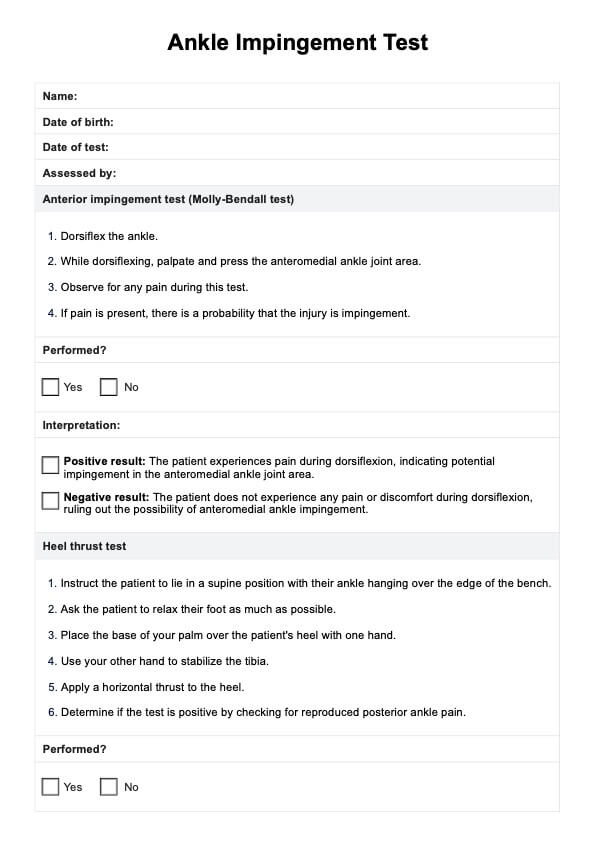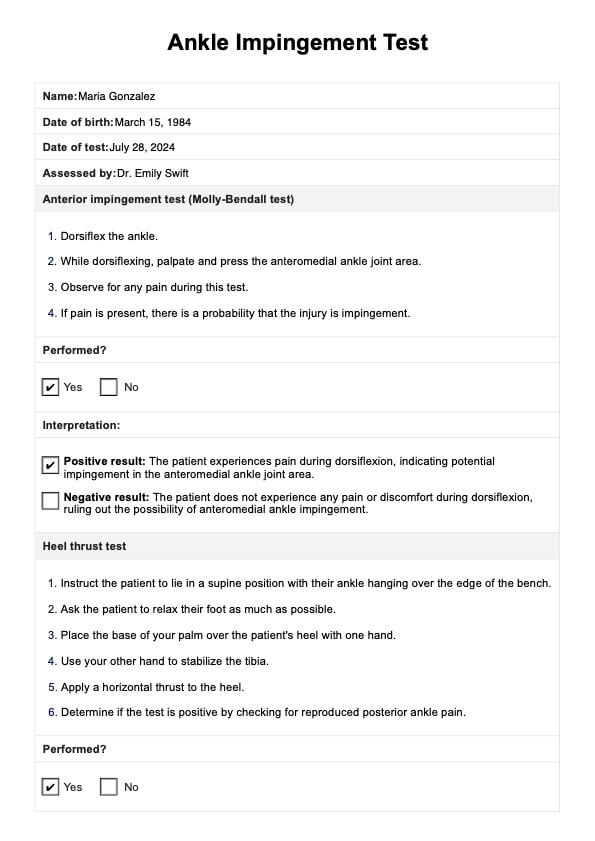Ankle Impingement Test
Learn about the Ankle Impingement Test, including how it's conducted, symptoms it identifies, and steps for effective diagnosis.


What is ankle impingement syndrome?
Ankle impingement syndrome refers to a condition where soft tissues or bony structures in the ankle are compressed. This compression typically occurs during specific movements, leading to pain and a restricted range of motion. The anterolateral impingement syndrome can manifest in different forms depending on the location of the impingement: anterior ankle impingement, commonly known as "footballer’s or anterolateral ankle impingement," occurs at the front of the ankle, and posterior ankle impingement affects the back of the ankle.
Symptoms of this syndrome
The primary symptom of ankle impingement syndrome is pain in the ankle, particularly when the foot is flexed up or down to extremes. This pain often worsens with activity, especially activities that involve repetitive ankle motion, such as running, jumping, or kicking. Swelling and tenderness over the affected area are also common. In severe cases, the pain may be persistent and can limit daily activities due to the discomfort and reduced ankle mobility.
Causes of this syndrome
Ankle impingement syndrome is typically caused by repetitive trauma or injury to the ankle that leads to the formation of scar tissue or bone spurs. In athletes, especially those participating in sports requiring repetitive ankle use like soccer, basketball, and ballet, such repetitive stress can cause these abnormalities. Anatomical factors such as naturally tight or misaligned joint structures can also predispose individuals to this condition.
Additionally, previous or chronic ankle pain or injuries, such as sprains, can contribute to the development of anterior impingement syndrome by altering the biomechanics of the ankle joint and leading to abnormal rubbing or pressure within the joint.
Ankle Impingement Test Template
Ankle Impingement Test Example
What is the Ankle Impingement Test?
The Ankle Impingement Test is a clinical assessment used to diagnose the presence of impingement syndromes in the ankle joint. It helps to identify whether ankle pain or discomfort is due to common ankle impingement syndromes or the compression of soft tissue or bony structures within the joint space during specific movements.
How is this test conducted?
The test is conducted by having the patient perform movements that elicit impingement symptoms. The examiner may perform passive movements or ask the patient to engage in them actively:
- Anterior ankle impingement test or Molly-Bendall test: The patient is asked to dorsiflex the foot (flex the foot upwards). At the same time, the examiner applies pressure on the back of the heel, driving the tibia (shinbone) forward over the foot. This maneuver compresses the front of the ankle.
- Heel thrust test: The patient lies in a supine position with their ankle hanging over the edge of the bench and ask them to relax their foot as much as possible. The examiner places the base of their palm over the patient's heel with one hand while using your other hand to stabilize the tibia. The examiner then applies a horizontal thrust to the heel and determine if the test is positive by checking for reproduced posterior ankle pain.
How are the results interpreted?
Positive test results occur when the patient experiences pain or significant discomfort in the specific area of impingement during the test:
- Positive Molly-Bendall test: Reproduction of pain in the posterior ankle may indicate a potential injury or condition.
- Positive hell thrust test: The patient experiences pain during dorsiflexion, indicating potential impingement in the anteromedial ankle joint area.
Next steps after conducting this test
If the ankle impingement test is positive, indicating the likelihood of an impingement syndrome, the following steps are typically recommended:
Step 1: Further diagnostic imaging
Tools like X-rays, MRI, or ultrasound may be used to confirm the diagnosis and assess the extent of the first anterior soft tissue impingement. Imaging helps identify bone spurs, soft tissue inflammation, or other structural abnormalities in soft tissue impingement.
Step 2: Referral to a specialist
Depending on the severity and persistence of symptoms, patients may be referred to a specialist, such as an orthopedic surgeon or a sports medicine physician, for further evaluation.
Step 3: Treatment planning
Treatment may involve conservative measures such as rest, ice application, anti-inflammatory medications, and physical therapy focused on stretching and strengthening the ankle. In cases where conservative treatment is ineffective, surgical options may be considered to remove the impinging structures and relieve symptoms.
How to use our Ankle Impingement Test template
This template is a standardized tool to evaluate potential ankle impingement in patients. It ensures consistency in testing and documentation, which is crucial for accurate diagnosis and follow-up.
Step 1: Integrate the template into your workflow
Implement the template as part of the routine evaluation for patients presenting with ankle pain or mobility issues. Ensure that all team members are trained to use the template properly to maintain consistency in data collection and patient assessment.
Step 2: Customize the template if necessary
Before using the template, review it to ensure it meets your practice's specific needs. Adjust any sections or terminology to better suit your clinical protocols or to include additional information relevant to your patient population.
Step 3: Educate patients about the test
Explain the purpose and procedure of the ankle impingement test to patients before starting. Ensuring they understand the reason for the test and what to expect can help obtain more accurate results, as patients are likely to be more cooperative and less anxious during the test.
Step 4: Use the template during assessments
Use the template consistently for every relevant patient. This helps create a systematic approach to diagnosing ankle impingement, allowing for easier data comparison over time or between different clinicians.
Step 5: Review and analyze the results
After completing the test, review the filled template to analyze the patient’s responses and the clinical findings. This analysis will guide the diagnostic decisions and the next steps in the patient's care plan.
Step 6: Maintain records for follow-up
Store the completed forms in the patient’s medical records for easy reference during follow-up visits. This will allow you to track the progression of the condition and the effectiveness of prescribed treatments over time.
Common treatments for ankle impingement syndrome
Common treatments for full posterior ankle pain and impingement syndrome focus on reducing inflammation, managing pain, and restoring mobility. The specific treatment approach can vary based on the severity of the symptoms and the underlying cause of the full posterior ankle impingement syndrome. Here are several widely used treatment options:
Rest and activity modification
Patients are often advised to reduce or modify activities that exacerbate chronic pain, such as running, jumping, or other repetitive impact activities. Resting the ankle helps decrease inflammation and prevent further irritation.
Physical therapy
Physical therapy is crucial for recovery from ankle impingement syndrome. A therapist may use techniques such as stretching and strengthening exercises to improve the range of motion and strengthen the muscles around the ankle. This helps alleviate anterior ankle impingement syndrome symptoms and reduces the risk of future injuries.
Ice and anti-inflammatory medications
Applying ice to the affected area can help reduce swelling and pain. Over-the-counter nonsteroidal anti-inflammatory drugs (NSAIDs) like ibuprofen or aspirin are commonly used to manage pain and decrease inflammation. In some cases, corticosteroid injections may be considered to provide more significant relief from inflammation.
Footwear and orthotic devices
Wearing appropriate footwear that provides sufficient support and cushioning can alleviate stress on the ankle. Orthotic devices or shoe inserts may be recommended to help correct structural abnormalities and distribute pressure on the foot or ankle more evenly during movement.
Surgical treatment
If conservative treatments fail to relieve symptoms of posterior impingement syndrome or if the ankle impingement is caused by structural abnormalities such as bone spurs, surgery may be necessary. Surgical options could involve removing the impinging bone or tissue to create more space within the joint, thus allowing smoother movement and reducing pain.
Follow-up care
Regular follow-up appointments with a healthcare provider are essential to monitor progress and adjust the treatment plan as needed. This ongoing care helps ensure the most effective recovery and prevent the recurrence of symptoms.
Commonly asked questions
Yes, you can walk with ankle impingement, but it may be painful, especially during activities that involve extending or flexing the ankle beyond its comfortable range of motion.
Risk factors for ankle impingement include repetitive ankle use in sports like soccer or basketball, previous injuries such as ankle sprains, and anatomical abnormalities that increase joint stress.
To strengthen ankle impingement, engage in physical therapy exercises that focus on improving range of motion, strengthening the muscles around the bony posterior ankle impingement, and enhancing overall ankle stability, including ankle dorsiflexion, plantar flexion, and gentle resistance training.







































































































